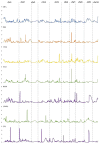QTL mapping identifies novel major loci for kernel row number-associated ear fasciation, ear prolificacy and tillering in maize (Zea mays L.)
- PMID: 36704171
- PMCID: PMC9871824
- DOI: 10.3389/fpls.2022.1017983
QTL mapping identifies novel major loci for kernel row number-associated ear fasciation, ear prolificacy and tillering in maize (Zea mays L.)
Abstract
Maize ear fasciation originates from excessive or abnormal proliferation of the ear meristem and usually manifests as flattened multiple-tipped ear and/or disordered kernel arrangement. Ear prolificacy expresses as multiple ears per plant or per node. Both ear fasciation and prolificacy can affect grain yield. The genetic control of the two traits was studied using two recombinant inbred line populations (B73 × Lo1016 and Lo964 × Lo1016) with Lo1016 and Lo964 as donors of ear fasciation and prolificacy, respectively. Ear fasciation-related traits, number of kernel rows (KRN), ear prolificacy and number of tillers were phenotyped in multi-year field experiments. Ear fasciation traits and KRN showed relatively high heritability (h 2 > 0.5) except ratio of ear diameters. For all ear fasciation-related traits, fasciation level positively correlated with KRN (0.30 ≤ r ≤ 0.68). Prolificacy and tillering were not correlated and their h 2 ranged from 0.41 to 0.78. QTL mapping identified four QTLs for ear fasciation, on chromosomes 1 (two QTLs), 5 and 7, the latter two overlapping with QTLs for number of kernel rows. Notably, at these QTLs, the Lo1016 alleles increased both ear fasciation and KRN across populations, thus showing potential breeding applicability. Four and five non-overlapping QTLs were mapped for ear prolificacy and tillering, respectively. Two ear fasciation QTLs, qFas1.2 and qFas7, overlapped with fasciation QTLs mapped in other studies and spanned compact plant2 and ramosa1 candidate genes. Our study identified novel ear fasciation loci and alleles positively affecting grain yield components, and ear prolificacy and tillering loci which are unexpectedly still segregating in elite maize materials, contributing useful information for genomics-assisted breeding programs.
Keywords: QTL mapping; ear fasciation; ear prolificacy; maize; tillering; yield components.
Copyright © 2023 Li, Tassinari, Giuliani, Rosignoli, Urbany, Tuberosa and Salvi.
Conflict of interest statement
Author CU was employed by the KWS SAAT SE & Co. KGaA. The remaining authors declare that the research was conducted in the absence of any commercial or financial relationships that could be construed as a potential conflict of interest. The authors declare that this study received funding from KWS SAAT SE & Co. KGaA. The funders had no role in data collection and analysis.
Figures




Similar articles
-
Genetic Architecture of Ear Fasciation in Maize (Zea mays) under QTL Scrutiny.PLoS One. 2015 Apr 29;10(4):e0124543. doi: 10.1371/journal.pone.0124543. eCollection 2015. PLoS One. 2015. PMID: 25923975 Free PMC article.
-
Identification of two new QTLs of maize (Zea mays L.) underlying kernel row number using the HNAU-NAM1 population.BMC Genomics. 2022 Aug 15;23(1):593. doi: 10.1186/s12864-022-08793-1. BMC Genomics. 2022. PMID: 35971070 Free PMC article.
-
QTL Mapping of Kernel Number-Related Traits and Validation of One Major QTL for Ear Length in Maize.PLoS One. 2016 May 13;11(5):e0155506. doi: 10.1371/journal.pone.0155506. eCollection 2016. PLoS One. 2016. PMID: 27176215 Free PMC article.
-
Hotspot Regions of Quantitative Trait Loci and Candidate Genes for Ear-Related Traits in Maize: A Literature Review.Genes (Basel). 2023 Dec 21;15(1):15. doi: 10.3390/genes15010015. Genes (Basel). 2023. PMID: 38275597 Free PMC article. Review.
-
Review: Recent advances in unraveling the genetic architecture of kernel row number in maize.Plant Sci. 2025 Mar;352:112366. doi: 10.1016/j.plantsci.2024.112366. Epub 2024 Dec 20. Plant Sci. 2025. PMID: 39710150 Review.
Cited by
-
Genome-Wide Association Studies on the Kernel Row Number in a Multi-Parent Maize Population.Int J Mol Sci. 2024 Mar 16;25(6):3377. doi: 10.3390/ijms25063377. Int J Mol Sci. 2024. PMID: 38542350 Free PMC article.
-
Mapping and Functional Analysis of QTL for Kernel Number per Row in Tropical and Temperate-Tropical Introgression Lines of Maize (Zea mays L.).Curr Issues Mol Biol. 2023 May 18;45(5):4416-4430. doi: 10.3390/cimb45050281. Curr Issues Mol Biol. 2023. PMID: 37232750 Free PMC article.
-
The genetic architecture of prolificacy in maize revealed by association mapping and bulk segregant analysis.Theor Appl Genet. 2023 Aug 9;136(9):182. doi: 10.1007/s00122-023-04434-7. Theor Appl Genet. 2023. PMID: 37555969
-
Genetic Mapping of QTL Associated with 100-Kernel Weight Using a DH Population in Maize.Plants (Basel). 2025 Jun 6;14(12):1737. doi: 10.3390/plants14121737. Plants (Basel). 2025. PMID: 40573725 Free PMC article.
-
Identification of yield-related QTLs and their applications using DH population in maize.BMC Genomics. 2025 Aug 2;26(1):719. doi: 10.1186/s12864-025-11920-3. BMC Genomics. 2025. PMID: 40753190 Free PMC article.
References
LinkOut - more resources
Full Text Sources

